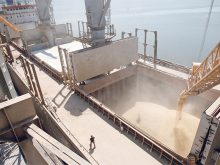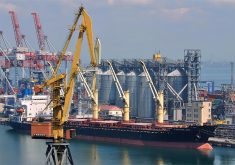Global food security is at risk from the war in Ukraine because the food system was already in trouble, said a panel discussing the Russian invasion.
Ted Bilyea, distinguished policy fellow at the Canadian Agri-Food Policy Institute, said the war is exacerbating existing issues.
Before the invasion, global food prices in the United Nation’s Food and Agriculture Organization’s index were the highest since the Great Grain Robbery in 1973, he said, and there have been five years of declining grain stocks.
Bilyea said most wheat stocks, for example, are not held by exporters.
Read Also

New coal mine proposal met with old concerns
A smaller version of the previously rejected Grassy Mountain coal mine project in Crowsnest Pass is back on the table, and the Livingstone Landowners Group continues to voice concerns about the environmental risks.
“China is expected to account for about 131 million tonnes of stock when we measure at the end of the year, or 47 percent of total global stocks of wheat,” he said. “And the major exporters only hold 57 million tonnes. If you look at what’s really going on here, we are so dependent on a new crop… because essentially if you take the world’s consumption, 781 million tonnes, what exporters hold is 27 days.”
China holds even more stocks of corn and rice, he said.
In addition, there was already a crisis in vegetable oil markets. Malaysian benchmark crude palm prices have risen 45 percent so far this year and the largest exporter of palm oil, Indonesia, restricted exports because of shortages and there was a smaller Canadian canola crop.
A major disruption in sunflower oil supply in Ukraine and a short soybean crop in South America entering the market are adding to the problem.
Bilyea said change in the meat trade will come because European countries import corn and barley from Ukraine. He said he expects to see pressure to change where meat is produced. Larger meat exporters, such as Spain, the Netherlands, Belgium and others, are also net importers of grain.
He said he learned while working in the meat business that it makes more economic sense to move animals to grain than grain to animals.
“Europe is going to want to have more food security; well, that’s not going to be stuffing grain that you have to buy from long distances into animals,” he said.
Shane Knutson, president of Polywest Ltd. in Winnipeg, does a lot of business in Ukraine. He said 95 percent of Ukraine’s wheat and other coarse grain went in the ground last fall as winter crops, but corn and sunflowers are typically seeded at the end of April and early May. The world is watching to see if that happens.
Total production is usually about 86 million tonnes, but about 61 million tonnes are typically exported, or about 12 percent of total world grain trade.
Ukraine is one of the largest sunflower producers at about 17.5 million tonnes per year.
“At least half of it is crushed in Ukraine and 91 percent of that is exported,” Knutson said. “On a global scale we trade 188 million tonnes of edible oils around the globe and (Ukraine) represents 16 million tonnes, which is about eight percent of global trade. That has an effect around the globe because that’s what everybody’s talking about, potential food scarcities.”
Knutson said Russia is also worth watching because while its production is likely to be less affected, its exports will. Russia produces about 120 million tonnes of grains and oilseeds and exports about 45 million tonnes. Most of that is wheat, at 35 million tonnes, and represents 17 percent of the global trade.
“So combined together, wheat on the Ukrainian side and wheat on the Russian side, represents almost 30 percent of the global trade of wheat and that’s why you see prices shooting way up,” Knutson said.
Customers for Russian products will change due to embargoes but the Black Sea closure is more significant, he said, as 90 percent of the grain exported from both countries goes out through the sea.
Knutson said about 40 percent of total exports would normally move between now and the end of harvest, which means stock is backing up. Storage and spoilage are major concerns, which add another layer to food security worries.


















